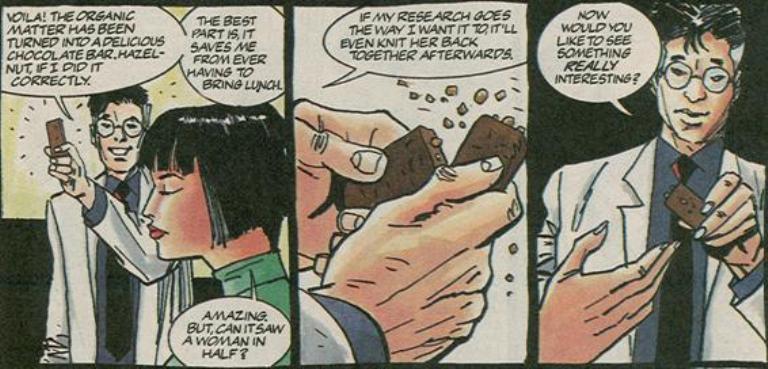Xombi 1 vs. Xombi 1
Reviewed by Richard Baez 29-Mar-11
Xombi, in its original incarnation (1994-96, 22 issues), was a title in the Milestone line, that grand mid-nineties experiment presided over by the recently deceased Dwayne McDuffie in tweaking mainstream comic archetypes via a more pronounced multicultural presence sans qualifiers. The series’ spotlight was placed upon David Kim, a research scientist endowed with nigh-immortality, an optimum body (always at its peak performance and never subject to aging), and the quirk of minor matter transmutation, all courtesy of that break-glass-here element of superhero comics, nanotechnology.
So… yes.
Xombi, in its original incarnation (1994-96, 22 issues), was a title in the Milestone line, that grand mid-nineties experiment presided over by the recently deceased Dwayne McDuffie in tweaking mainstream comic archetypes via a more pronounced multicultural presence sans qualifiers. The series’ spotlight was placed upon David Kim, a research scientist endowed with nigh-immortality, an optimum body (always at its peak performance and never subject to aging), and the quirk of minor matter transmutation, all courtesy of that break-glass-here element of superhero comics, nanotechnology. Wackiness was known for ensuing, with the original run of the series oft remembered for its emphasis less on traditional superheroics and more the tone of absurdist horror which was prevalent all throughout; in this, Xombi bore a relationship to the more straight-shooting Milestone shared universe analogous to Swamp Thing, Doom Patrol and all the rest of your own personal Suggested-For-Mature-Readers pantheon to the DCU in those more porous pre-Vertigo days – a series apart, yet still breathing the same air.
I never read the title myself – my taste in comic bookery, in those heady years of mid-nineties teen angst, ran more towards those officially designated bad for me, with polymorphous sexuality and Dave McKean covers more typical fare – so if you recognized the above paragraph as standard-issue boilerplate, kudos. What we’re concerned with is the actual Xombi #1 – both the first issue (sorta)*, propped up neither by a Wikipedia page nor an Alan Moore blurb, and the current glossy-paged revival eagerly awaiting you at your local retailer. I embark upon this enterprise not to bury or to praise but to ponder, as is my wont.
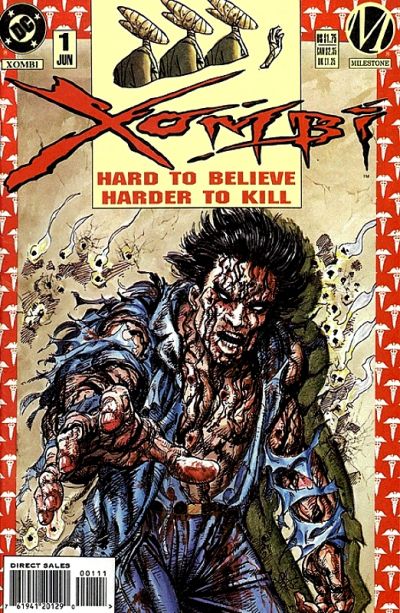 As this is a book seventeen years past the date of its release, there will be some SPOILERS AHOY. But this should prove a relatively painless experience – it is after all, an origin issue and, as such, a spoiler’s playground.
As this is a book seventeen years past the date of its release, there will be some SPOILERS AHOY. But this should prove a relatively painless experience – it is after all, an origin issue and, as such, a spoiler’s playground.
Like many a U-NEED-THIS comic book cover, it’s not necessarily representative of the contents; while the issue certainly has its share of blood, you’d be hardpressed to find any adrenaline-enhanced sneers accompanying heroic poses. You were wrong, Mr. Byrne. No, the predominant tone is the humdrum, that necessity if genre is to properly swoop in and make David Kim its plaything for the sake of our $1.75 a month, all prelude before the main event.
We open with a brief prologue boding terror to come, with a nun superhero, Nun Of The Above (I approve), and her sidekick Catholic Girl on the case – I deeply hope, as the older issues accumulate in my Subspace Longbox during the coming months, to discover Xombi as a covert papist funnybook salvo upon Jack T. Chick and his all-encompassing pamphleteering empire. Then the main plotline: David guiding a (very) friendly female colleague through a tour of what will perhaps prove to be plot points in future issues at his cutting-edge research lab, all exposition and overly flirtatious banter – no, temptress, our David stands firm, pining for his betrothed, currently far, far away in some distant land. Meanwhile, forces of an unknown and eldritch nature close in, meticulously picking off the menial staff until finally taking aim at our hero for reasons unexplained. And so, perched upon the steep precipice of death, a last second application of SCIENCE propels David to headliner status. The final page reveals a man risen anew and the inadvertent self-sacrifice of his colleague – she ends up as the necessary nanomachine-ready raw material for his rebirth (due, notably, to her cradling him, ala the Pieta, in his hour of need – I did mention the nun superhero on the first page, right?), her earlier innuendoes no doubt sealing her fate thanks to the inescapable morality of genre. Of course, as she, with that final gesture, now ably straddles both sides of the virgin-whore complex (and our tale is TO BE CONTINUED…), who’s to say her days of ambiguity have concluded?
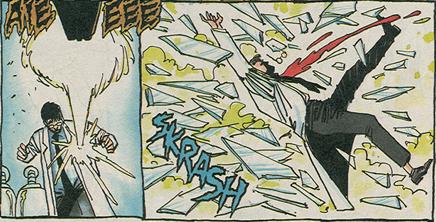 The issue judged on sheer mechanics: a B-. Rozum’s no great shakes and wears his influences proudly and to distraction (more on that later), but he delivers some solid storytelling, managing to, if not mask, then maneuver through the huge swaths of set-up a premiere issue demands. Artist J. J. Birch arts everything up in a scratchy angular style that at times achieves a charming muralesque effect in terms of flatness, all painted in that nifty washed-out color style that dominated the Milestone line. He can be awkward to be sure – occasionally his facial expressions can be jarringly stiff, particularly with the scenes of terror where a stray character’s panic will register from panel to panel as the sad aftereffects of a stroke, but he manages to connect the dots well enough most of the time. So yeah, I’ll pick up the next issue, presuming I come across it during one of my bi-weekly back-issue bonanzas or can get the time machine in my basement in good enough order that it’ll manage 1994 and not 1564, as its been doing lately. (Smallpox is a bitch, you know?)
The issue judged on sheer mechanics: a B-. Rozum’s no great shakes and wears his influences proudly and to distraction (more on that later), but he delivers some solid storytelling, managing to, if not mask, then maneuver through the huge swaths of set-up a premiere issue demands. Artist J. J. Birch arts everything up in a scratchy angular style that at times achieves a charming muralesque effect in terms of flatness, all painted in that nifty washed-out color style that dominated the Milestone line. He can be awkward to be sure – occasionally his facial expressions can be jarringly stiff, particularly with the scenes of terror where a stray character’s panic will register from panel to panel as the sad aftereffects of a stroke, but he manages to connect the dots well enough most of the time. So yeah, I’ll pick up the next issue, presuming I come across it during one of my bi-weekly back-issue bonanzas or can get the time machine in my basement in good enough order that it’ll manage 1994 and not 1564, as its been doing lately. (Smallpox is a bitch, you know?)
Character-wise, there are, of course, antecedents. You wouldn’t be off-base if you described Xombi’s (maybe we’re calling him that?) origin as well-worn: the scientist, the catastrophe, and the transformation into something of a type before unseen – the beginnings of a few thousand other superhuman figures, some heroes, some villains, and some misunderstood monsters set to have a climactic meeting with the National Guard. Within that mold, you could probably name a few more characters who, like David Kim, have crossed that threshold of calamitous science and found themselves in its mirror realm, one inhabited largely by creatures unconfined by rationality. An immediate contender is Swamp Thing, granddaddy of mainstream “maturity”**; the same grand rupture in each unleashes our hero, another version of reason-run-amok, to hold back a horde of countless variations of childhood terror. Just a thought.
Oh, but there’s more than one ghost at this feast.
How’s that for a reference, Niles Caulder fans!
Yes, that’s a wink for those with eyes to see, a deliberate nod to another series where the wonder of tiny tech were utilized to create a chocolate bar and whose influence looms large over many a page of this issue: Grant Morrison’s run on Doom Patrol. The first issue goes beyond mere valentine, almost baiting the knowing reader into following the elements back to that source. The wheelchair-bound research supervisor. The sinister catalysts of catastrophe who bear the same body-wrapping (albeit around a different frame) and green trenchcoat as a certain duo-gendered, ever-floating Doom Patrol member. The (belabored) emphasis on nanotechnology, which dominated DP’s third act (a notion later to find full narrative fruition in Morrison’s The Filth). Et cetera.
It’s not quite a Xerox, of course. Xombi is probably a touch more earthbound than the earlier series, with its persistent word-play and off-kilter-idea-every-five-panels rhythm, nor is it likely to be beholden, as Doom Patrol was at bottom, to the tried-and-true superhero mold of Lee and Kirby’s Fantastic Four. And if that series went wherever Grant’s Dream Journal compelled it, with the horrific just one way station between DIY art appreciation and space epic, Xombi, if the blood-drenched-exposed-spinal-column closing image of the first issue may be read as tone-setting, will probably be more focused on horror, less wayward in all the issues in between.
But this is all speculation, speculation long after the fact at that. Xombi, its initial run, lasted another 20 issues, the eventual victim of low sales figures.
Mind you, mainstream comics have always been a revival-happy medium, the relentless cult of nostalgia on both the supply and demand side working in neat tandem with the alienated labor endemic to any corporate environment (“Hell, I’m not giving THEM my best ideas!”) to ensure the cyclical existence of the industry’s properties; what appeared once will appear again – braver and bolder, or some semblance thereof, on the next go-round. And sometimes this effect will trickle down to the most forlorn figures in a company’s stable, lost or abandoned at the time, but for the continued residence they’ll take in the memories of the few, as is the way with most comics. Thus…
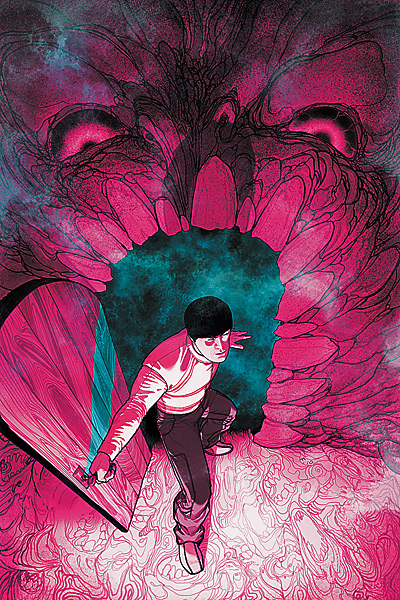 We begin where we ended with that last (and first) issue: resurrection! Extratextual resurrection, specifically.
We begin where we ended with that last (and first) issue: resurrection! Extratextual resurrection, specifically.
I’d say that’s a cover we can all stand behind, well barring the misspelling of Frazer Irving’s name. I know an apt metaphor when I see it – our hero exiting an abyss and warily entering someplace new, a sinister location where even the doorway through which he enters bodes a grim fate within. Or maybe even ready to snap shut upon his frame and prove his purported invincibility a frail notion, casting it back into the limbo of imaginary stories, beyond continuity, beyond corporate “relevance”. Welcome back to the Direct Market, Xombi.
You might be reasonably certain that the agony of influence would have flagged a bit for Mr. Rozum – surely seventeen years would be enough to escape the shadow of a certain My Chemical Romance video star/author of The Mystery Play. You’d be wrong.
Xombi, quite often, may very well be the “Decreator” storyline in Doom Patrol (issues 31 – 33, true believers) expanded into an ongoing series***, that saga of a cult bent on invoking the eponymous being, the antithesis to God’s thesis, for the purposes of bringing about an Apocalypse not by catastrophe but by pieces. In each issue another introduction to a few more ragged and elaborate creatures drawn from the same distinct confluence of Christian mythology and childhood ephemera, all distinctly working at a logic tangential to our own (a logic the narrative captions are always ready to delineate). Children made into monsters, abandoned pleasures ready to wreak havoc… you’ll find them there and you’ll find them here.
That bald specter just can’t help but haunt this series, not just in the direct influence dept. but also in the presence of newly ascended “fan favorite” artist Frazer Irving, familiar to many courtesy of various Morrison projects, most recently as one of the few reliable cogs in Morrison’s “Batman travels through time for some reason” grand storyline, never mind Seven Soldiers: Klarion The Witch-Boy (or Joe Casey’s fine and oft-overlooked Iron Man: The Inevitable mini, for that matter). So let this book be the one you currently curse for whatever Gutsville withdrawal symptoms you’re undergoing.
So with that detail in mind, the divide between now and then can only be made more total. There will be none of Birch’s flat textures to be found here, not when the man responsible for this master class in perspective is our co-pilot.
No significant spoilers, because I respect the pact of economic novelty. Or something.
We begin in medias res and at full gallop with a synchronized absurdity bit, an easy go-to when a writer has no real idea of how to get a scene started. It’s a neat effect that always manages to be both obviously lazy (clearly some isolated notes that have just been piling up in the notebook) and yet still effective: the all-this-completely-crazy-isolated-shit-is-happening-all-over-the-world-at-the-exact-same-moment catalog of incidents. The resultant energy is as facile as a sugar rush but the import always registers.
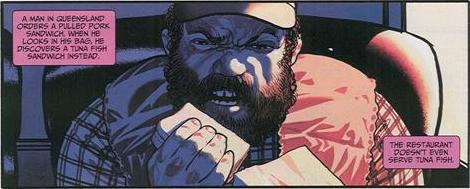 SO: danger’s afoot – get me Xombi!
SO: danger’s afoot – get me Xombi!
The working status quo is then established (a decade-and-a-half of our time working out to perhaps a few days for our hero, if we judge by the tone of his narration) with Irving managing a lovely and near-superfluous approach to the info-dump: nearly three splash pages of time elapsing across single spaces (click here and scroll down a bit for glimpse) – David Kim just hanging at a friend’s house, getting a beer and reminiscing to himself – albeit not quite as dynamic as Franks King or Quitely might have pulled off. The sense of space as it’s inhabited is nice, particularly with the slightly unconventional emphasis on space in relation to the reader (dude, it’s like Playtime!), but the gestures across the panels seem too discreet to carry too much weight, never mind Irving’s more painterly and illustrative method, which works against the feel of motion. There’s a less ostentatious method of depicting time w/r/t space in this scene later on in the book…
 …which can make these pages feel a little like hand-holding. But they do gain quite a bit of weight when seen less in traditional “splash page” terms (i.e. declarative statements) and more as larger-than-average panels, with one panel abutting another – rhyming effects, essentially, with color and character placement the key elements.
…which can make these pages feel a little like hand-holding. But they do gain quite a bit of weight when seen less in traditional “splash page” terms (i.e. declarative statements) and more as larger-than-average panels, with one panel abutting another – rhyming effects, essentially, with color and character placement the key elements.
And you know what – I take back what I’m saying: the relationship between the foreground and the extreme foreground of the first page of the sequence – the photo “panels” – is a dead-on piece of cartooning, particularly seen in the context of movement and narration; a damn fine use of unseen space. It sings.
Oh, and then stuff happens for about another fifteen pages. Lotsa stuff. Books infect reality, some great darkness approaches, et al. Next month a nun shoots guns. Based on a true story.
GRADE: E for EFFORT. Impressive and weightless. What it really needs is a bit more visceral effect, maybe – an exposed spinal column would probably help. Viewed with a cursory knowledge of what came before, it feels like it’s own victory banner – on with the show, ‘cause hey, who the hell ever thought we’d get the chance, we’re back and we need to make up for lost time, lookie-loos be damned!
So, as a single aesthetic object intent upon delivering a satisfying reading experience, it falls short. Heaven knows many of Xombi’s bestapled brethren are guilty of similar sins but to a more egregious degree, placing the weight of a hundred back issues upon the most innocuous panels, but we’re not grading on a curve here. Perusing it without much immediate knowledge of its original incarnation (a fate I valiantly avoided, as documented above), you wouldn’t necessarily be lost (let’s not neglect Irving’s pyrotechnic exposition) but you would probably just wonder at it. This happens and then this happens and then this happens, but not much of it felt, the distance from the eye to the page a gulf of 21 (or 22 (or 23****)) issues. It moves, sure, but without momentum.
Those nanomachines may rebuild you, but that will only take you so far. If you really want to survive, you need to adapt.
FOOTNOTES
*As with most series that saw fit to premiere in the nineties (and more than a few today), Xombi was initially ushered into the grubby clutches of the consumer via an issue #0; all evidence points to this being a tie-in to a line wide event, with our protagonist David Kim well enough past his origin and engaged in whatever cataclysm threatened the Milestone universe at the time. Hype-building for the soon-to-come series, essentially.
** Er, and maybe Morbius?
*** SELF-INDULGENT MUSING, BY ALL MEANS AVOID:
Xombi, quite often, may very well be the “Decreator” storyline in Doom Patrol expanded into an ongoing series
And maybe it somehow is. As of March 16, 2010, the Decreator and the Rustling Husks (1) from Xombi and that dude who stuffed every girlfriend of every superhero in the DCU into kitchen appliances, et al., all occupy the same fictive space, their fictional Leaning Tower of Pisa the same fictional Leaning Tower of Pisa and not the unmentioned Leaning Tower of Pisa in, say, Gravity’s Rainbow and not Marvel’s Leaning Tower Of Pisa and not our own Leaning Tower of Pisa, i.e. the one that actually displaces air. I suppose what I’m circling around is that the sensibilities of both works in question being so similar, there is the possibility their respective contents may converge and we might glimpse the Decreator anew in his proper place, on the page, his gigantic bloodshot eye glaring down upon David Kim and pals, instead of just in my long-gestating Decreator fanfic where he hangs out with Ego, the Living Planet; they share an apartment.
If you’re emotionally invested in these here shared universe continuities, I suspect watching them continually shatter and merge – fires of creation and destruction continually stoked by unprofitability, company buyouts, the second-guessing of editorial committees, or maybe the writer just didn’t get the memo – can prove a source of some frustration, the chess board in which you have some psychic stake overturning itself every few months or so in a herky-jerky manner, but from the perch of the disinterested observer it really is a sight to behold. Consider Xombi, Morrison’s iteration of the Doom Patrol and their relation to the DCU: a hypothetical chart would show (and this is grossly simplified) two becoming three, then returning to two, and eventually merging into one – Xombi, being a Milestone property, began quite separate from the DCU, until very recently, when Milestone became official DC property, whilst Doom Patrol began firmly in the DCU (they hung out with the JLE or something – Animal Man made a crack about his weird, wacky life. Remember?), in the straight-ahead lineage of Drake & Premiani, but, at the behest of Morrison’s scorched-earth conclusion or maybe just a plain old retcon or something, was jettisoned off into its own imaginary domain. That lasted for a decade, I think, until a few years back, when they re-emerged from limbo and back into continuity as a result of cosmic cataclysm, as is often the way. Nor is it coincidental that the resurgence of Doom Patrol and Milestone should occur at roughly the same moment, nostalgia’s own large and very bloodshot eye currently quite focused on the early to mid-nineties.
All these artificial, fantastical people and who they can and can’t hang out with. This kind of thing happens all the time.
(1) “Decreator and the Rustling Husks.” Now there’s a band name.
**** Oddly, Xombi arose once during his decade-and-a-half long state of hibernation to star in The Brave And The Bold #26 in 2008 by John Rozum and Scott Hampton. He hung out with The Spectre, apparently.
Tags: DC, Frazer Irving, J. J. Birch, John Rozum, Milestone, Xombi